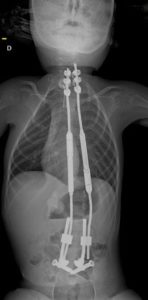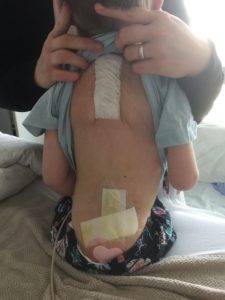If you thought an autonomous robot dentist implanting 3D printed teeth into a patient’s mouth was astoundingly innovative and maybe a little scary, buckle your seat belt – for the first time, a robot has completed spinal surgery on a child with severe progressive scoliosis. The groundbreaking surgery took place at the University Hospital of Amiens (CHU d’Amiens) in France.
6-year-old Louis is handicapped with a genetic disorder known as infantile spinal amyotrophy – his back was bent at an extreme angle, which has caused him some breathing trouble. Rehabilitation, back braces, and orthopedic corsets were not helping, and he has spent the last six months lying flat in bed.
A robot named ROSA was tasked with completing a very important part of the obviously necessary surgery: the installation of ilio-sacral screws into the patient’s spine.
“It was a question of placing illio-sacral screws and hooks at the top of the back, connected by arched rods to straighten the back,” explained Professor Richard Gouron, the patient’s head of surgery. “The installation of the screws seven millimeters in diameter in a bone corridor of eight millimeters near the roots nervous system remains very complex and rare, they are voluminous in view of the small size of the child’s bones.”
Over the past year, Professor Gouron, pediatric orthopedic surgeon Dr. François Deroussen, and neurosurgeon Dr. Michel Lefranc have been working tirelessly to simulate the robotic operation before it took place.
Dr. Lefranc said, “The surgeon plans the operation, the robot carries the instruments, and takes into account the movements of the patient. He brings the precision and three-dimensional vision.”
Thanks to 3D printing technology, a reproduction of the young patient’s spinal column was added to a mannequin for simulation purposes, so that the 15-person surgical team could practice ahead of time, and even simulate the entire operation twice before even attempting it on Louis.
“This is two firsts in one. A first in simulation, and a first surgery, the placement of ilio-sacral screws with the help of a robot,” explained Professor Gouron.”The incisions are smaller thanks to the robot, there is less post-operative pain and the patient can sit more quickly.”
- Post-surgery X-ray
- Louis sitting up on 8 October
We’ve seen studies that show 3D printed surgical models can save on costs, but more importantly, they can also reduce the amount of time patients have to spend on the operating table, because it gives surgeons the chance to practice complicated procedures ahead of time.
The successful surgery took place on September 28th, and it only took three hours to place screws in the pelvis and hooks at the top of the back, which were then connected by rods. Louis has recovered very well – not only can he breathe better, but he can also sit up correctly again.
Dr. Deroussen, who originally initiated the project, said, “This is a great victory.”
Due to the success of this first robotic spinal surgery, four other children will soon have identical surgeries to fix their spines.
Source : 3dPrint , 11 Oct 2017





No comments:
Post a Comment